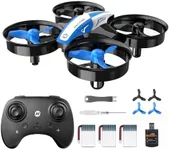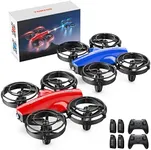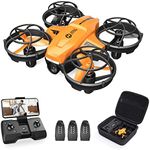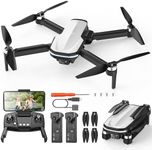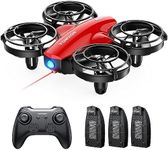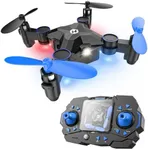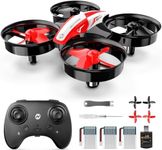Buying Guide for the Best Drone For Kids
Choosing a drone for kids can be a fun and rewarding experience, but it's important to focus on safety, ease of use, and durability. Kids' drones are designed to be simple to operate and resilient to bumps and crashes. When shopping, think about where the drone will be used (indoors or outdoors), the age and skill level of the child, and any features that might make flying more enjoyable or educational. Always prioritize safety features and make sure the drone is appropriate for the child's age.Size and WeightSize and weight refer to how big and heavy the drone is. For kids, smaller and lighter drones are usually better because they are easier to control and less likely to cause damage or injury if they crash. Drones can range from tiny palm-sized models to larger ones that need more space to fly. If the drone will be used indoors, a small and lightweight model is ideal. For outdoor use, a slightly larger drone can handle wind better, but it should still be manageable for a child.
Flight TimeFlight time is how long the drone can stay in the air on a single battery charge. Most kids' drones have a flight time between 5 and 15 minutes. Shorter flight times mean more frequent recharging, which can be frustrating for kids. However, longer flight times often come with larger drones or more expensive batteries. Consider how patient the child is and whether you can buy extra batteries to swap out for longer play sessions.
Ease of UseEase of use covers how simple the drone is to fly and control. Features like one-button takeoff and landing, altitude hold, and headless mode make flying much easier for beginners. Drones with these features are great for kids because they reduce the learning curve and help prevent crashes. If the child is very young or new to drones, look for models that advertise beginner-friendly controls.
DurabilityDurability is about how well the drone can withstand crashes and rough handling. Kids are likely to crash their drones, especially when learning, so a sturdy build is important. Drones made with flexible plastic and protected propellers (propeller guards) are less likely to break. If the drone will be used by younger children or in tight spaces, prioritize durability to ensure it lasts longer.
Safety FeaturesSafety features include things like propeller guards, emergency stop buttons, and low-battery warnings. These features help prevent injuries and protect both the child and the drone. Propeller guards are especially important for younger kids, as they prevent fingers from touching spinning blades. If safety is a top concern, make sure the drone has these protective features.
CameraSome kids' drones come with built-in cameras, allowing kids to take photos or videos while flying. Camera quality can range from basic to high-definition, but for most kids, a simple camera is enough for fun. If the child is interested in photography or video, look for a drone with a camera, but remember that adding a camera can make the drone slightly heavier and more complex to use.
Control RangeControl range is the maximum distance the drone can fly from the controller before losing connection. Kids' drones usually have a shorter range, from about 30 to 100 meters. A shorter range is safer for beginners, as it keeps the drone within sight and easy to retrieve. If the drone will be used in a large outdoor area, a longer range might be useful, but for most kids, a moderate range is sufficient.
